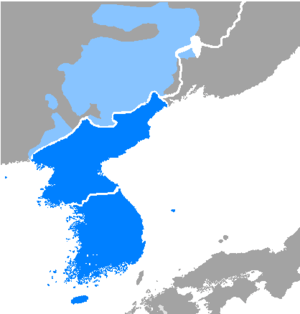Koreanic languages
| Koreanic | |
|---|---|
| Geographic distribution: | Korea, Northeast China, Manchuria |
| Linguistic classification: | One of the world's primary language families |
| Subdivisions: | |
| Glottolog: | kore1284[1] |
|
The Koreanic languages | |
The Koreanic languages are a language family consisting of the modern Korean language together with extinct ancient relatives closer to it than to any proposed links with Mongolic, Turkic, Tungusic, or Japanese. Among extant languages, Korean is considered by most linguists to be a language isolate and by others as part of the widely rejected Altaic family or the Dravido-Korean languages.[2] Some even suggest an Austronesian languages connection.[2] Alexander Vovin, an expert on North-East-Asian languages, suspects, through his research, that the origin of Koreanic is not Altaic origin but Paleosiberian.[3] He supports the inclusion of Korean in the Paleosiberian languages family. The Jeju language of Jeju Island, considered by some as a dialect of modern Korean, is distinct enough to be considered a language in its own right by other authorities. Some consider that rather than being a language isolate, Korean forms a small language family, together with Jeju.
Classification
The periodization of the historical stages of Korean is as follows:
- Before 1st century: Proto-Korean
- 1st to 10th century: Old Korean
- 10th to 16th century: Middle Korean
- 17th century to present: Modern Korean
Ancient Koreanic languages
Several ancient languages of the Korean peninsula—Silla, Buyeo, Goguryeo, Dongye, Okjeo, Baekje, Gojoseon and Ye-Maek—may have been ancestral to, related to, or part of Old Korean. Two branches are sometimes posited, Buyeo and Han.[4]
Modern Koreanic languages
Modern Korean is traditionally considered a single language. However, Jeju (Cheju) is sometimes classified as a distinct language, for example in the UNESCO atlas on endangered languages. If that is accepted, there are two modern Koreanic languages, Jeju and Korean proper.[5]
Members
- Koreanic Languages (한국어족)
- Ye-Maek language (예맥어)
- Buyeo languages (부여어족)
- Goguryeo language (고구려어)
- Buyeo language (부여어)
- Baekje language (백제어)
- Goguryeo language (고구려어)
- Sillan languages (신라어족)
- Korean language (한국어, 조선말)
- Hamgyŏng dialect (Northeastern dialects; 함경 방언, 동북 방언)
- Koryo-mar (고려말)
- Northwestern dialects (서북 방언)
- Pyongan dialect (평안 방언)
- Hwanghae dialect
- Yukchin dialect (육진 방언)
- Central dialects.[6] (중부 방언)
- Gyeonggi dialect (Seoul dialect; 경기 방언, 서울말)
- Yeongseo dialect (영서 방언)
- Chungcheong dialect (충청 방언)
- Yeongdong dialects[6] (영동 방언)
- Gyeongsang dialect (Southeastern dialects; 경상 방언, 동남 방언)
- Northern Gyeongsang dialect (북부 동남 방언)
- Southern Gyeongsang dialect (남부 동남 방언)
- Jeolla dialect (Southwestern dialects; 전라 방언, 서남 방언)
- Northern Jella dialect (북부 서남 방언)
- Southern Jella dialect (남부 서남 방언)
- Various dialects
- Zainichi Korean language (재일 한국어)
- Korean language in China (중국조선말)
- Hamgyŏng dialect (Northeastern dialects; 함경 방언, 동북 방언)
- Jeju language (제주어)
- Korean language (한국어, 조선말)
See also
- History of the Korean language
- Gaya language
- Tsushima dialect, a Japanese dialect influenced by Korean.
References
- ↑ Hammarström, Harald; Forkel, Robert; Haspelmath, Martin; Bank, Sebastian, eds. (2016). "Koreanic". Glottolog 2.7. Jena: Max Planck Institute for the Science of Human History.
- 1 2 "ORIGIN THEORIES". linguistics.byu.edu. Retrieved 2016-11-01.
- ↑ "Korean as a Paleosiberian Language (English version of 원시시베리아 언어로서의 한국어)". Retrieved 2016-11-01.
- ↑ Young Kyun Oh, 2005. Old Chinese and Old Sino-Korean
- ↑ Janhunen, Juha, 1996. Manchuria: an ethnic history
- 1 2 Lee & Ramsey, 2000. The Korean language
